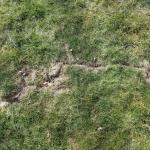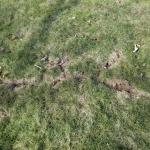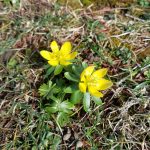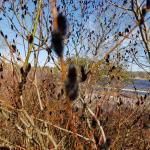UMass Extension's Landscape Message is an educational newsletter intended to inform and guide Massachusetts Green Industry professionals in the management of our collective landscape. Detailed reports from scouts and Extension specialists on growing conditions, pest activity, and cultural practices for the management of woody ornamentals, trees, and turf are regular features. The following issue has been updated to provide timely management information and the latest regional news and environmental data.
Welcome to the first Landscape Message of the 2022 reporting year. Happy Spring! The next message will be posted on April 8. To receive immediate notification when the next Landscape Message update is posted, be sure to join our e-mail list
To read individual sections of the message, click on the section headings below to expand the content:
Scouting Information by Region
Environmental Data
The following data was collected on or about March 16, 2022. Total accumulated growing degree days (GDD) represent the heating units above a 50° F baseline temperature collected via regional NEWA stations (http://newa.cornell.edu) for the 2022 calendar year. This information is intended for use as a guide for monitoring the developmental stages of pests in your location and planning management strategies accordingly.
|
Region/Location |
GDD |
Soil Temp |
Precipitation |
Time/Date of Readings | |||||
| 2021 Total | 2021 Current | Sun | Shade | Since 1/1 | Since 3/1 | ||||
|
Cape Cod |
3075 | 6 (BE 21) | 41 | 38 | 10.02 | 1.23 | 12:00 PM 3/16 | ||
|
Southeast |
3066 | 12 | 54 | 41 | 11.37 | 0.95 | 3:00 PM 3/16 | ||
|
North Shore |
3111 | 7 | * | * | 7.19 | 0.94 | 10:00 AM 3/16 | ||
|
East |
3148 | 14 | 46 | 43 | 6.66 | 1.13 | 5:00 PM 3/16 | ||
|
Metro West |
2902 | 6 | 40 | 38 | 6.28 | 0.75 | 6:00 AM 3/16 | ||
|
Central |
2978 | 2 | 40 | 42 | 9.09 | 1.37 | 7:00 AM 3/16 | ||
|
Pioneer Valley |
3018 | 1 | 43 | 38 | 5.16 | 1.28 | 10:00 AM 3/16 | ||
|
Berkshires |
2461 | 0 | 37 | 34 | 6.24 | 1.12 | 9:00 AM 3/16 | ||
|
AVERAGE |
2970 | 6 | 43 | 39 | 7.35 | 1.10 | - | ||
|
* = information not available |
|||||||||
Phenology
| Indicator Plants - Stages of Flowering (BEGIN, BEGIN/FULL, FULL, FULL/END, END) | ||||||||
|---|---|---|---|---|---|---|---|---|
| PLANT NAME (Botanic / Common) | CAPE | S.E. | N.S. | EAST | METRO W. | CENT. | P.V. | BERK. |
| Hamamelis x intermedia (witch hazel hybrids) | Full/End | Full |
Full |
Full |
Full |
Full/End |
Full/End |
Full |
| Hamamelis mollis (Chinese witch hazel) | Full/End |
Full |
Full |
Full |
Full |
Full/End |
Full/End |
Full |
| Acer saccharinum (silver maple) |
Begin |
Begin | Begin | Begin | Begin | Begin | Begin | * |
| * = no activity to report/information not available | ||||||||
Regional Notes
Cape Cod Region (Barnstable)
General Conditions: December 2021 averaged 41ᣞF with 1.75” precipitation. The 2021 total precipitation was 45.01”. Much of the winter included erratic temperature fluctuations with temperatures often going from well above average for a couple days followed by a couple days of much colder temperatures. The average temperature for January was 30ᣞF with a high of 52ᣞF on January 17 and a low of 3ᣞF on January 31. The average temperature for February was 35ᣞF with a high of 61ᣞF on February 23 and a low of 8ᣞF on February 15. So far in March the average temperature is 39ᣞF with a high of 63ᣞF on March 15 and a low of 17ᣞF on March 1.
Precipitation came in the form of both snow and rain. The largest snowstorm occurred on January 28-29 with snow totals of 12-18”. Several other snow events occurred but with rather small accumulations typically 2-5”. Snow cover was short lived except for the two weeks following the late January storm. Several storm events included strong winds resulting in widespread small branch debris. Soils froze relatively shallowly (3-4” in most locations) in January and early February and have since thawed and are less muddy then just a short while ago.
A rather warm late fall resulted in some bloom of plants like forsythia in late November and early December before settling into dormancy in early to mid December. Though temperatures were erratic, there were no extended warm periods (winter thaws) since mid-December, so plants have remained dormant. Witch hazel (Hamamelis x intermedia ‘Arnold Promise’) is toward the end of bloom, silver maple (Acer saccharinum) and some willows (Salix spp.) are beginning to bloom. Snow drops (Galanthus spp.) have been in bloom for a couple of weeks as well as some southern facing patches of crocuses (Crocus spp.). Hellebore (Helleborus orientalis) is beginning to bloom and trailing arbutus (Epigaea repens) with southern exposures are beginning to bloom. I have heard from several folks who have heard peepers in recent days.
Pests/Problems: The typical winter issues are being seen including orange and bronze boxwoods; some needled evergreens are showing winter bronzing and some de-icing salt damage. The effects of white pine needle disease can be seen in areas with a lot of white pine. An occasional 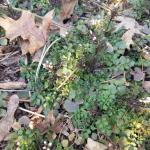
random pitch pine can be seen with an orange/brown crown as the result of turpentine beetle damage. Mole and vole damage is visible on the edge of many lawns. Some girdling has been seen on thin barked shrubs and trees, usually from rabbit or vole. Red thread and pink snow molds have been seen active on lawns. Winter annuals such as hairy bittercress (Cardamine hirsuta) are beginning to bloom. Ticks are active.
Southeast Region (Dighton)
General Conditions: According to the NOAA weather station in Dighton: in January we had 4.43 inches of rainfall equivalent, some of which fell as 29.4 inches of snow or ice pellets. In February we had 5.99 inches of rainfall equivalent, some of which fell as 12.2 inches of snow or ice pellets. So far in March there's been 0.95" of rainfall equivalent, some of which fell as 1.4 inches of snow or ice pellets. We've had a total of 11.37 inches of rainfall equivalent since the beginning of the year. Winter aconite (Eranthis hyemalis), and snowdrop (Galanthus nivalis), were in bloom on February 24 as were hairy bittercress (Cardamine hirsuta), and chickweed (Stellaria media) in sunny locations. Honey bees and flies were evident feeding on nectar and pollen at the open flowers at that time. Flowers of Crocus tommasinianus, the purple species of crocus, were open by February 28. Silver maple (Acer saccharinum) was in flower on March 7th. Salix gracilistyla 'Melanostachys', black pussy willow, catkins were observed on March 13. In flower March 15 were Japanese andromeda (Pieris japonica), and Chinese witch hazel (Hamamelis mollis).
Pests/Problems: Meadow voles made ample use of the opportunity to mine and damage turf while unobserved under snow cover.
North Shore (Beverly)
General Conditions: Temperatures in January and February were quite variable, with some days below average and some days above average. January was very cold with a minimum temperature of 1˚F. The average daily temperature was 25˚F, the average minimum temperature of 16˚F and an average maximum temperature of 33˚F. February temperatures were seasonable with a minimum temperature of 5˚F. The average temperature was 31˚F, average minimum temperature 21˚F and an average maximum temperature of 31˚F. During the months of January and February, we received 6.25 inches of precipitation in the form of rain or melted snow. Temperatures in the first half of March have been a mixture of below average and above average. The minimum temperature recorded was 5˚F and the maximum temperature recorded was 63 ̊F. Signs of spring are evident with some plants starting to bloom. Early spring flowering bulbs seen in bloom include winter aconite (Eranthis hyemalis), ‘Tommie’ Crocus (Crocus tommasinianus) and snowdrops (Galanthus nivalis). Trees seen in bloom include: ‘Arnold Promise’ witch hazel (Hamamelis x intermedia), Chinese witch hazel (Hamamelis mollis), pussy willow (Salix caprea) and silver maple (Acer saccharinum). 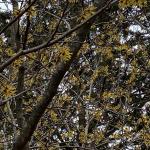
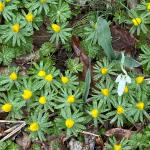
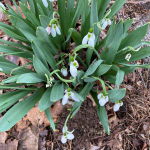
Pests/Problems: Serious deer browsing damage was observed on many evergreen shrubs including yews (Taxus sp.), rhododendrons and some arborvitae. Surprisingly, no vole tunnels were observed, unlike previous years when they were plentiful.
East Region (Boston)
General Conditions: We had an extended fall in 2021; December temperatures averaged 45ᣞF. We ended the year with a total of 3144 growing degree days accumulating through November. This region went a record 321 days without accumulating an inch of snow until January 7. We experienced a blizzard on January 22 when we received just over a foot of light blowing snow and high winds. January temperatures averaged 35ᣞF with a high of 52ᣞF. February began with precipitation and an ice storm between the 3rd and the 5th totaling 1.59” of rain equivalent. We had another snow event on February 25th. Temperatures averaged 43ᣞF, with four days reaching 60ᣞF and a high temperature of 68ᣞF on the 23rd. Halfway through March, temperatures have averaged 48ᣞF and we received 1.13” of precipitation. We have gained 14 GDD’s thus far in 2022. Soils are thawed and moist. Crocus spp. (crocus), Eranthis hyemalis (winter aconite), Galanthus nivalis (snowdrops), Hamamelis mollis (Chinese witch hazel), Hamamelis x intermedia “cultivars” and Helleborus orientalis (lenten rose) are flowering. Praying mantis egg cases (oothecae) have been observed on dried herbaceous material overwintering in the garden.
Pests/Problems: Deer and rabbit damage is visible throughout the landscape. Winter burn is visible on exposed evergreens.
Metro West (Acton)
General Conditions: Weather highlights for this winter season include: 2.11” of rain recorded for the month of January and 3.42” recorded for February, a low of -7.6°F on January 31st, 6 additional days with sub-zero readings in January and February, a high of 70°F on February 23rd, from year to date there have been 7 additional days with temperatures recorded in the 60s and it appears that number will increase according to the forecast for the next few days. Official spring is two days away and signs of it are here including the following plants in bloom: Adonis amurensis (Amur adonis), Galanthus spp. (snowdrops), Hamamelis x intermedia “cultivars (witch hazel), and Hamamelis mollis (Chinese witch hazel). Buds are swelling on our maple trees, the sound of peepers peeping has begun and buckets are collecting sap.
Pests/Problems: This past Saturday’s late winter storm event with strong winds and wind gusts (recorded up to 35 mph) resulted in much woody debris scattered around the landscape and erosion in areas. Mud season is here with the ground thawing and softening. Visible now is the small rodent damage to lawns.
Central Region (Boylston)
General Conditions: This winter felt relatively average here in the central region, although snowfall totals for the year were disappointing (for those of us who enjoy big snowstorms anyway). This week’s warmer than average temperatures have melted all but the largest piles of snow remaining from the last few snowstorms. Soils are waterlogged, but early spring bulbs are showing. Galanthus nivalis (snowdrops) and Crocus spp. (crocus) are up and showing color. Hamamelis mollis and H. x intermedia (witch hazel) have been blooming for several weeks. The first of the spring peepers (Pseudacris crucifer) started their early spring calls this week!
Pests/Problems: This is the time of year that broken limb damage from the weight of winter snow and ice starts to reveal itself in evergreen species. Soils are waterlogged and mud is abundant.
Pioneer Valley Region (Amherst)
General Conditions: The vernal equinox is upon us (3/20) as we officially transition to spring. With the increasing day lengths, temperatures and sun intensity, it certainly feels like spring. Overall, the ‘21–‘22 winter season (December through February) had above-average temperatures and below-average snowfall in the Pioneer Valley. February was particularly warm, with seven days recording high temperatures >50°F. However, January was downright cold, with an average low of 12°F (Deerfield) and five days with sub-zero low temperatures. Additionally, wind chills routinely dropped below zero, in some cases exceeding -20°F. Those ambient air temperatures and wind chill values were certainly capable of causing winter injury to semi-hardy plants. The valley bottom registered approximately 25” of snow for the season, well below normal, with the largest accumulation coming on 2/25 (~7” in Easthampton). Near record temperatures in the mid-60s on 3/6 and rain on 3/7 quickly melted the remaining snow and two subsequent snow storms have also quickly melted. Depending on sun exposure, soils are either still frozen or saturated. While there’s much to do in the landscape, compaction of saturated soils due to foot traffic or equipment is a concern. However, where soils are thawed and reasonably drained, new tree and shrub planting is possible at this time. The slowly warming soil and air temperatures can help ease the shock of transplant, giving plants several months in the ground before the intense heat of summer arrives.
Pests/Problems: Strong winds over the past several weeks have caused damage to trees throughout the region. On 3/8, sustained winds were >30 mph and gusts were near 50 mph (Barnes Airport, Westfield). As soils continue to slowly thaw but remain saturated, uprooting of conifers due to strong winds will be a concern until proper drainage can occur. Hopefully, deer and rabbit repellents were successful in protecting susceptible plants, like arborvitae, yews, rhododendron and azaleas (among others depending on local pressure). Voles and moles are active and their activities over the winter months should be clear now. It’s still too cold for most disease-causing pathogens and insect pests, so their activity is not a concern right now. One pest that should be closely scouted for is the spruce spider mite. Damage that occurs in April may not be visible until the summer months, at which time it’s too late for treatment. This cool season mite can cause serious damage on a variety of landscape conifers, including spruce, arborvitae, false-cypress and hemlock. (See more below in the Insect Section.)
Berkshire Region (Great Barrington)
General Conditions: It’s been a yo-yo start to the year with temperatures fluctuating from frigid to unusually mild over the course of just a few days. For example, the low temperature as recorded at the Pittsfield Airport on March 5th was 5°F. The next day, temperatures rose to a record high of 61°F for the date. Precipitation in terms of both snowfall and rainfall equivalent since the beginning of the year have been both a little below normal. Soils currently are saturated as they have only recently begun to thaw. Soils are muddy and it is best to refrain from treading on turfgrass and gardens to prevent soil compaction. Witch hazel (Hamamelis mollis and several cultivars of H. x intermedia) were seen coming into bloom at a site in North Egremont back on February 12th. These are now in full flower. Snowdrops (Galanthus nivalis) were blooming at a site in Sheffield in late February and are now blooming in the central Berkshires.
Pests/Problems: Muddy soils may be the focus now and as mentioned above, it is best to stay off these soggy soils. There have been a few heavy wet snow events this winter which resulted in broken tree and shrub limbs, as well as some power outages, but the biggest problem has been the frequency and strength of wind gusts. Gusts of 50 or more mph have occurred on many occasions and the sight of toppled trees/broken branches has been common. Many of these branches are still hanging on trees and pose possible danger depending upon location. 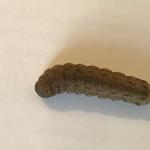
 Black-legged ticks are active and pets out on a stroll have come back home with ticks attached. Another critter observed this week was what appeared to be a winter cutworm (Noctua pronuba). As the name implies, these caterpillars are cold tolerant.
Black-legged ticks are active and pets out on a stroll have come back home with ticks attached. Another critter observed this week was what appeared to be a winter cutworm (Noctua pronuba). As the name implies, these caterpillars are cold tolerant.
Regional Scouting Credits
- CAPE COD REGION - Russell Norton, Horticulture and Agriculture Educator with Cape Cod Cooperative Extension, reporting from Barnstable.
- SOUTHEAST REGION - Brian McMahon, Arborist, reporting from the Dighton area.
- NORTH SHORE REGION - Geoffrey Njue, Green Industry Specialist, UMass Extension, reporting from the Long Hill Reservation, Beverly.
- EAST REGION - Kit Ganshaw & Sue Pfeiffer, Horticulturists reporting from the Boston area.
- METRO WEST REGION – Julie Coop, Forester, Massachusetts Department of Conservation & Recreation, reporting from Acton.
- CENTRAL REGION - Mark Richardson, Director of Horticulture reporting from Tower Hill Botanic Garden, Boylston.
- PIONEER VALLEY REGION - Nick Brazee, Plant Pathologist, UMass Extension Plant Diagnostic Lab, reporting from Amherst.
- BERKSHIRE REGION - Ron Kujawski, Horticultural Consultant, reporting from Great Barrington.
Woody Ornamentals
Diseases
Upcoming webinar on April 5, 2022 (6:30-7:30 pm): Management of Eastern White Pine (Pinus strobus) in the Landscape: What does the future hold?
- Winter burn: Overall, winter temperatures (December through February) were above-average across southern New England. But during the month of January, some bitterly cold conditions occurred, with ambient air temperatures below zero (1/15–16, 1/22, 1/27 and 1/31) and wind chill values between -20 to -30°F. It’s during this time that susceptible trees and shrubs could have been injured, especially plants that are hardy only to USDA zones 5 or 6. Microclimates and wind exposure play a significant role in which particular plants are injured. Drought stress will weaken a plant’s ability to acclimate to cold temperatures. However, that shouldn’t have been a factor across much of southern New England last season with the record-setting rainfall. Over the next several weeks, it should become obvious which plants were affected. Pay particular attention to rhododendron, boxwood, Japanese maple, false-cypress, Atlas cedar, among others that are semi-hardy in our region. Rhododendron leaves may appear pale green, remain curled and become increasingly desiccated as temperatures consistently warm up. For conifers, their color may appear normal at first, but the needles will feel dry and somewhat brittle. To date, winter burn seems limited but much remains to be revealed.
- Phytophthora root rot: From April through October 2021, 41.7” of rainfall was recorded (statewide average). On poorly-drained sites with heavy soils, this incredible amount of rain created ideal conditions for Phytophthora root and crown rot. There is tremendous diversity of native and non-native Phytophthora species in Massachusetts and these pathogens are also widespread on nursery stock. Phytophthora thrives in saturated and flooded soils, producing a swimming, asexual spore that attaches to and penetrates into susceptible roots. Fine root mortality leads to colonization of larger roots. In some cases, the disease progresses to the root crown and the plant is starved of water and nutrients. As the disease develops, symptoms are most consistent with drought stress. There are no curative treatments for plants badly diseased by Phytophthora, but preventative soil drenching with labeled fungicides can provide protection in areas where Phytophthora root and crown rot has been a problem in the past. Additional information can be found at http://ag.umass.edu/landscape/fact-sheets/phytophthora-root-crown-rot.
Report by Nick Brazee, Plant Pathologist, UMass Extension Plant Diagnostic Lab, UMass Amherst.
Insects
Welcome Back to the 2022 Landscape Message!
I can’t think of a better way to start than to announce a renewed effort to create a Professional Insect & Mite Management Guide for Woody Plants! This is a project that I have been struggling to finalize (due to its magnitude) since 2016. Yikes! And I recognize that professionals have been eagerly awaiting progress in this area. While it is still not yet ready, I hope that once it is available, at least some will agree that it was worth the wait.
The current goal is that this management guide will be freely available on the Landscape, Nursery and Urban Forestry Program website. If available/known to science, it will contain information about growing degree days, host plants, insect descriptions, damage to hosts, monitoring, cultural management, natural enemies and biological control, and chemical active ingredients that might be used (if absolutely necessary) to manage each insect. This guide will be specific to Massachusetts, and right now contains over 240 insect pests of trees and shrubs that I continue to gather science-based information for. It will be searchable by insect common and scientific name, as well as host plant.
With the help of Caroline Schelleng, undergraduate at the University of Massachusetts, Amherst, and Evonne Gong, Web Designer/Online Strategist for the Center for Agriculture, Food, and the Environment, I am hopeful that this guide will be a useful addition to the professional land manager’s toolbox. (I would also like to acknowledge past help from Amanda Backstrom, former undergraduate at the University of Massachusetts.)
As soon as the Professional Insect & Mite Management Guide for Woody Plants is available, Landscape Message readers will be among the first to know! Thank you for your patience, and continued interest in insect pests of trees and shrubs!
An Update about Neonicotinoid Use in Massachusetts:
Beginning July 1, 2022, systemic insecticide active ingredients known as neonicotinoids will become state restricted use for tree and shrub uses in Massachusetts. If an individual works in the commercial industry (landscapers, arborists, etc.), then a Commercial Certification License is needed. (Example: Category 36 Commercial Certification License, Shade Trees & Ornamentals.) Someone can use a state or federal restricted use pesticide if they have a Commercial Applicators License as long as they are working under the direct supervision of someone with a Commercial Certification. Unlicensed or uncertified individuals will no longer be able to apply neonicotinoids to manage insect pests of trees and shrubs in Massachusetts.
More information is available, here: https://www.mass.gov/service-details/pesticide-newsupdates
Insects and Other Arthropods
To begin the season, while insect activity remains low and plants are still dormant, I want to take the time to provide a few updates regarding invasive, non-native insect pests of trees and shrubs. These updates will then be followed by a select few species that may be useful to include in your springtime scouting. But prior to that, a quick reminder about ticks, which are active any time temperatures are above freezing. Here’s to the very best in the 2022 growing season!
-
Deer Tick/Blacklegged Tick: Ixodes scapularis adults have been active all winter, as they typically are from October through May, and “quest” or search for hosts at any point when daytime temperatures are above freezing. Engorged females survive the winter and will lay 1,500+ eggs in the forest leaf litter beginning around Memorial Day (late May). For images of all deer tick life stages, along with an outline of the diseases they carry, visit: https://web.uri.edu/tickencounter/species/blacklegged-tick/ .
Anyone working in the yard and garden on springtime cleanup and planting should be aware that there is the potential to encounter deer ticks. The deer tick or blacklegged tick can transmit Lyme disease, human babesiosis, human anaplasmosis, and other diseases. Preventative activities, such as daily tick checks, wearing appropriate clothing, and permethrin treatments for clothing (according to label instructions) can aid in reducing the risk that a tick will become attached to your body. If a tick cannot attach and feed, it will not transmit disease. For more information about personal protective measures, visit: https://web.uri.edu/tickencounter/prevention/protect-yourself/ .
The Center for Agriculture, Food, and the Environment provides a list of potential tick identification and testing resources here: https://ag.umass.edu/resources/tick-testing-resources .
Woody ornamental insect and non-insect arthropod pests to consider, a selected few:
Invasive Insects & Other Organisms Update:
-
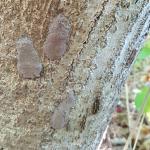 Spotted Lanternfly: (Lycorma delicatula, SLF) is a non-native, invasive insect that feeds on over 103 species of plants, including many trees and shrubs that are important in our landscapes. It overwinters as an egg mass, which the adult female insect lays on just about any flat surface. Pictures of egg masses can be seen here: https://massnrc.org/pests/linkeddocuments/SLFChecklistForResidents.pdf.
Spotted Lanternfly: (Lycorma delicatula, SLF) is a non-native, invasive insect that feeds on over 103 species of plants, including many trees and shrubs that are important in our landscapes. It overwinters as an egg mass, which the adult female insect lays on just about any flat surface. Pictures of egg masses can be seen here: https://massnrc.org/pests/linkeddocuments/SLFChecklistForResidents.pdf.
Currently, the only established populations of spotted lanternfly in Massachusetts are in a small area in both Fitchburg and Shrewsbury, MA. Therefore, there is no reason to be preemptively treating for this insect in other areas of Massachusetts. If you suspect you have found spotted lanternfly in additional locations, please report it immediately to MDAR here: https://massnrc.org/pests/slfreport.aspx . If you are living and working in the Fitchburg and Shrewsbury areas, please be vigilant and continue to report anything suspicious.
For More Information:
From UMass Extension:
Check out the InsectXaminer Episode about spotted lanternfly adults and egg masses! Available here: https://ag.umass.edu/landscape/education-events/insectxaminer
Fact Sheet: https://ag.umass.edu/landscape/fact-sheets/spotted-lanternfly
From the MA Department of Agricultural Resources:
Fact Sheet and Map of Locations in MA: https://massnrc.org/pests/pestFAQsheets/spottedlanternfly.html
-
Asian Longhorned Beetle: (Anoplophora glabripennis, ALB) Look for signs of an ALB infestation which include perfectly round exit holes (about the size of a dime), shallow oval or round scars in the bark where a female has chewed an egg site, or sawdust-like frass (excrement) on the ground nearby host trees or caught in between branches. Be advised that other, native insects may create perfectly round exit holes or sawdust-like frass, which can be confused with signs of ALB activity.
The regulated area for Asian longhorned beetle is 110 square miles encompassing Worcester, Shrewsbury, Boylston, West Boylston, and parts of Holden and Auburn. If you believe you have seen damage caused by this insect, such as exit holes or egg sites, on susceptible host trees like maple, please call the Asian Longhorned Beetle Eradication Program office in Worcester, MA at 508-852-8090 or toll free at 1-866-702-9938.
To report an Asian longhorned beetle find online or compare it to common insect look-alikes, visit: http://massnrc.org/pests/albreport.aspx or https://www.aphis.usda.gov/pests-diseases/alb/report .
-
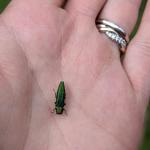 Emerald Ash Borer: (Agrilus planipennis, EAB) has been detected in at least 11 out of the 14 counties in Massachusetts. A map of these locations across the state may be found here: https://ag.umass.edu/fact-sheets/emerald-ash-borer . Additional information about this insect is provided by the MA Department of Conservation and Recreation, here: https://storymaps.arcgis.com/stories/b60f63199fa14805a8b9f7c82447a25b .
Emerald Ash Borer: (Agrilus planipennis, EAB) has been detected in at least 11 out of the 14 counties in Massachusetts. A map of these locations across the state may be found here: https://ag.umass.edu/fact-sheets/emerald-ash-borer . Additional information about this insect is provided by the MA Department of Conservation and Recreation, here: https://storymaps.arcgis.com/stories/b60f63199fa14805a8b9f7c82447a25b .
This wood-boring beetle readily attacks ash (Fraxinus spp.) including white, green, and black ash and has also been found developing in white fringe tree (Chionanthus virginicus) and has been reported in cultivated olive (Olea europaea). Signs of an EAB infested tree may include D-shaped exit holes in the bark (from adult emergence), “blonding” or lighter coloration of the ash bark from woodpecker feeding (chipping away of the bark as they search for larvae beneath), and serpentine galleries visible through splits in the bark, from larval feeding beneath. It is interesting to note that woodpeckers are capable of eating 30-95% of the emerald ash borer larvae found in a single tree (Murphy et al. 2018). Unfortunately, despite high predation rates, EAB populations continue to grow. However, there is hope that biological control efforts will eventually catch up with the emerald ash borer population and preserve some of our native ash tree species for the future.
-
Spongy Moth: Lymantria dispar egg masses will be seen overwintering on just about any flat surface, including host plants such as oak, but also fencing, buildings, steps, outdoor furniture, and more. The end of winter and start of spring is a good time to scout properties, particularly in areas of Berkshire County, MA that experienced elevated L. dispar populations in 2021. If large numbers of egg masses are seen, plan to monitor them between 90-100 growing degree days (roughly the first week in May, but this varies) to better time egg hatch and caterpillar emergence. If egg masses are plentiful near high-value specimen trees in Berkshire County in 2022, consider applying the reduced risk insecticide Bacillus thuringiensis Kurstaki (Btk) to host plant leaves before caterpillars are over ¾ inch in length.
Why did the common name for Lymantria dispar change recently? More information is available here: https://entsoc.org/news/press-releases/spongy-moth-approved-new-common-name-lymantria-dispar .
-
Winter Moth: (Operophtera brumata) data since 2017 has indicated that the winter moth population in eastern Massachusetts has been on the decline while the percentage of winter moth pupae parasitized by Cyzenis albicans has increased! Dr. Joseph Elkinton’s laboratory at UMass Amherst has released this biological control of winter moth since 2005 and conducted the rigorous sampling required to determine where the insect has established and what its impact on the winter moth population has been at multiple sites in eastern MA. More information about the Elkinton Lab’s research and the biological control of winter moth can be found here: https://www.fs.fed.us/foresthealth/technology/pdfs/FHAAST-2018-03_Biology_Control_Winter-Moth.pdf
The take-home point? Do not worry about winter moth this spring! In fact, management of this insect in landscaped settings will likely not be necessary in most locations. Blueberry growers may still, on the other hand, be interested in scouting and continuing to monitor for this insect, as only very low numbers of winter moth caterpillars might be tolerated in that system. In recent years, it is worthwhile to note that some areas on the Cape and other locations in eastern MA have reported noticeable cankerworm populations in the spring, which are often confused for winter moth. Read more about cankerworms in the spring scouting list below.
-
Jumping Worms: Amynthas spp. earthworms, collectively referred to as “jumping or crazy or snake” worms, overwinter as eggs in tiny, mustard-seed sized cocoons found in the soil or other substrate (ex. compost). The tiny, impossible to remove cocoons will overwinter and provide a population of these earthworms in the 2022 season.
For More Information:
UMass Extension Fact Sheets:
- Earthworms in Massachusetts – History, Concerns, and Benefits: https://ag.umass.edu/landscape/fact-sheets/earthworms-in-massachusetts-history-concerns-benefits
- Jumping/Crazy/Snake Worms – Amynthas spp.: https://ag.umass.edu/landscape/fact-sheets/jumpingcrazysnake-worms-amynthas-spp
A Summary of the Information Shared at UMass Extension’s Jumping Worm Conference in January 2022: https://ag.umass.edu/news-events/highlights/jumping-worms-conference
Spring Scouting Suggestions & Preparation for Upcoming Tree & Shrub Insect Pests:
-
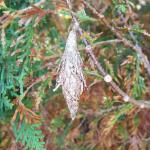 Bagworm: Thyridopteryx ephemeraeformis is a native species of moth whose larvae construct bag-like coverings over themselves with host plant leaves and twigs. This insect overwinters in the egg stage, within the bags of deceased females from last season. Eggs may hatch and young larvae are observed feeding around mid-June, or roughly between 600-900 GDD’s. Now is the time to scout for and remove and destroy overwintering bags. More information can be found here: https://ag.umass.edu/landscape/fact-sheets/bagworm
Bagworm: Thyridopteryx ephemeraeformis is a native species of moth whose larvae construct bag-like coverings over themselves with host plant leaves and twigs. This insect overwinters in the egg stage, within the bags of deceased females from last season. Eggs may hatch and young larvae are observed feeding around mid-June, or roughly between 600-900 GDD’s. Now is the time to scout for and remove and destroy overwintering bags. More information can be found here: https://ag.umass.edu/landscape/fact-sheets/bagworm
-
Balsam Twig Aphid: Mindarus abietinus overwinters as a silvery colored egg on host plant twigs. Eggs hatch just prior to budbreak and nymphs feed for a period of time on the undersides of last season’s needles before molting into a wingless stem mother. Stem mothers move to buds just as they open and give “live birth” to second generation nymphs. These second generation nymphs are the most damaging, feeding on new needles as they elongate, causing distortion and stunting. Excessive amounts of honeydew may be produced and cause needles to stick together. Foliar applications, if needed, may be made between 30-100 GDD’s, base 50°F on warm days before budcaps loosen. Inspect the twigs, near the base of needles of Balsam fir, Fraser fir, and other true firs for overwintering eggs and eventually the needles for feeding nymphs. This insect may be most problematic in Christmas tree production. In landscapes, many natural enemies can provide adequate management of this insect.
-
Boxwood Leafminer: Monarthropalpus flavus partly grown fly larvae overwinter in the leaves of susceptible boxwood. Yellowish mines may be noticeable on the undersides of leaves. This insect grows rapidly in the spring, transforming into an orange-colored pupa. After pupation, adults will emerge and white colored pupal cases may hang down from the underside of leaves where adults have emerged. Adults may be observed swarming hosts between 300-650 GDD’s, or roughly the end of May through June. Most cultivars of Buxus sempervirens and B. microphylla are thought to be susceptible. If installing new boxwoods this spring, resistant cultivars such as ‘Vardar Valley’ and ‘Handsworthiensis’ are good choices at sites where this insect has been a problem.
-
Boxwood Mite: Eurytetranychus buxi overwinter as tiny eggs on boxwood leaves and hatch mid-spring. These mites are tiny (about the size of a period) and difficult to detect. Feeding may cause plants to appear off-color. If management is deemed necessary, the timing for treatment may be between 245-600 GDD’s or roughly the beginning of May.
-
Boxwood Psyllid: Psylla buxi feeding can cause cupping of susceptible boxwood leaves. Leaf symptoms/damage may remain on plants for up to two years. English boxwood may be less severely impacted by this pest. Eggs overwinter, buried in budscales, and hatch around the budbreak of boxwood. Eggs may hatch around 80 GDD’s. While foliar applications may be made between 290-440 GDD’s, the damage caused by this insect is mostly aesthetic. Therefore, typically, management is not necessary.
-
Cankerworms: Alsophila pometaria (fall cankerworm) and Paleacrita vernata (spring cankerworm) are often confused for winter moth (Operophtera brumata). Cankerworm populations in eastern MA, particularly on areas of Cape Cod, were confused for winter moth in 2019. Spring cankerworm adults are active in February and March, and fall cankerworm adults are active in late November into early December. During these times, both species lay eggs. These native insects most commonly utilize elm, apple, oak, linden, and beech. Eggs of both species hatch as soon as buds begin to open in the spring. Caterpillars occur in mixed populations and are often noticeable by mid-May in MA. Young larvae will feed on buds and unfolding leaves. There are two color forms (light green and dark) for caterpillars of both species. Like winter moth, they will drop to the soil to pupate. This usually occurs in June. Fall cankerworm larvae have three pairs of prolegs (one of which is small so it is sometimes referred to as ½) and spring cankerworm have two pairs. (Winter moth caterpillars also have 2 pairs of prolegs.) If populations are large and damage is noticeable on hosts, reduced risk insecticides such as Bacillus thuringiensis Kurstaki or spinosad may target larvae between approximately 148-290 GDD’s.
-
Cooley Spruce Gall Adelgid: Adelges cooleyi is a native insect that has a complex life cycle. It has at least five different morphological forms, and requires 2 years and two hosts to complete its normal life cycle. Galls (pineapple shaped/cone-like and at the tips of twigs) are produced on Colorado blue spruce, Engelmann, Sitka, and Oriental spruce and cause needle injury (yellow spots and distortion) to Douglas-fir. Immature females overwinter on spruce near twig terminals. In the early spring, females mature into stem mothers and lay hundreds of eggs on lateral terminals. Upon egg hatch, nymphs migrate to new spring growth and feed at the base of growing needles. Immatures can be targeted on spruce between 22-81 GDD’s (mid-late April). On Douglas-fir, dormant oil applications should be made immediately before budbreak to avoid phytotoxicity. Follow all label instructions.
-
Eastern Spruce Gall Adelgid: Adelges abietis is a pest of Norway spruce primarily, but occasionally damages other spruce species such as Colorado blue, white, and red spruce. This adelgid overwinters as a partially grown female, often referred to as a stem mother. This overwintering individual matures around bud break and lays 100-200 eggs. The eastern spruce gall adelgid may be targeted for management between 22-170 GDD’s, base 50°F (mid-April to early-May). This insect is non-native, and was introduced into the United States from Europe before 1900. Galls are small, sometimes pineapple shaped/variable, but produced on the basal portion of the shoots, such that the twig extends beyond the gall. Twig dieback may occur.
-
Eastern Tent Caterpillar: Malacosoma americanum eggs overwinter on host plant twigs. Egg hatch typically occurs when wild cherry leaves begin to unfold and young caterpillars may emerge by late-April through the first two weeks in May (90-190 GDD’s). Susceptible hosts include cherry and crabapple. Other host plants whose leaves are fed upon by this native insect can include apple, ash, birch, willow, maple, oak, poplar, and witch-hazel. Prune off and remove egg masses from ornamental host plants by early spring. Eastern tent caterpillars are native to Massachusetts and have many associated natural enemies (parasites and predators) that help regulate populations. Unless these caterpillars are actively defoliating specimen trees in a landscaped setting, we can coexist with this particular herbivore native to our forests.
-
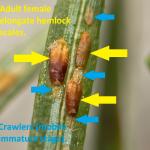 Elongate Hemlock Scale: Fiorinia externa is found on eastern, Carolina, and Japanese hemlock, as well as yew, spruce, and fir. The elongate hemlock scale may overwinter in various life stages, and overlap of many developmental stages at any given time can be observed throughout much of the season. Dormant oil applications for this pest can occur according to label instructions in April, roughly between 7-120 GDD’s. Treatments for the crawler, or mobile, stage of this insect may be made in late May through mid-June, or between 360-700 GDD’s, base 50°F. Nitrogen fertilizer applications may make elongate hemlock scale infestations worse.
Elongate Hemlock Scale: Fiorinia externa is found on eastern, Carolina, and Japanese hemlock, as well as yew, spruce, and fir. The elongate hemlock scale may overwinter in various life stages, and overlap of many developmental stages at any given time can be observed throughout much of the season. Dormant oil applications for this pest can occur according to label instructions in April, roughly between 7-120 GDD’s. Treatments for the crawler, or mobile, stage of this insect may be made in late May through mid-June, or between 360-700 GDD’s, base 50°F. Nitrogen fertilizer applications may make elongate hemlock scale infestations worse. -
Euonymus Scale: Unaspis euonymi is an armored scale that can be found on euonymus, holly, bittersweet, and pachysandra. This insect can cause yellow spotting on leaves, dieback, and distorted bark. Dormant oil applications can be made between 35-120 GDD’s or roughly from mid-April to early-May. For crawlers, early June timing is suggested between 533-820 GDD’s. (Eggs begin to hatch in early June.)
-
European Pine Sawfly: Neodiprion sertifer overwinters in the egg stage. Eggs are laid by females the previous season by cutting slits in needles using their ovipositors and depositing 6-8 eggs in each of 10-12 needles. Egg hatch occurs from late-April to mid-May and caterpillars become active roughly between 78-220 GDD, base 50°F. The primary host in MA is Mugo pine but it can be found on Scots, red, jack, and Japanese red pine. It is also found on white, Austrian, ponderosa, shortleaf, and pitch pine when planted near the aforementioned species. This dark colored caterpillar feeds in tight groups and small numbers can be pruned or plucked out of host plants and destroyed. Spinosad products can be used whenever the caterpillars are actively feeding, usually by mid-May and when caterpillars are still small. Bacillus thuringiensis kurstaki is not effective against sawflies.
-
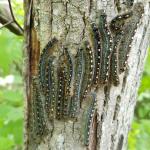 Forest Tent Caterpillar: Malacosoma disstria egg hatch occurs between 192-363 GDD’s, base 50°F, by mid-late May and caterpillars may be active for at least 5-6 weeks following. Susceptible hosts whose leaves are fed on by this insect include oak, birch, ash, maple, elm, poplar, and basswood. This native insect has many natural enemies, including some very effective pathogens that typically regulate populations. However, outbreaks of this insect can occur on occasion.
Forest Tent Caterpillar: Malacosoma disstria egg hatch occurs between 192-363 GDD’s, base 50°F, by mid-late May and caterpillars may be active for at least 5-6 weeks following. Susceptible hosts whose leaves are fed on by this insect include oak, birch, ash, maple, elm, poplar, and basswood. This native insect has many natural enemies, including some very effective pathogens that typically regulate populations. However, outbreaks of this insect can occur on occasion.
-
Hemlock Looper: Two species of geometrid moths in the genus Lambdina are native insects capable of defoliating eastern hemlock, balsam fir, and white spruce. Adult moths lay their eggs on the trunk and limbs of hosts in September and October, and eggs will hatch by late May or early June. (L. fiscellaria caterpillars may be active between 448-707 GDD’s.) Monitor susceptible hosts for small, inch-worm-like caterpillars. Where populations are low, no management is necessary. Hemlock loopers have several effective natural enemies.
-
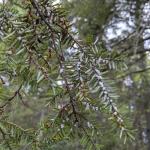 Hemlock Woolly Adelgid: Adelges tsugae is present on eastern and Carolina hemlock. The overwintering hemlock woolly adelgid generation (sistens) is present through mid-spring and produces the spring generation (progrediens) which will be present from early spring through mid-summer. HWA, unlike many other insects, does most of its feeding over the winter. Eggs may be found in woolly masses at the base of hemlock needles beginning in mid-March. Each woolly mass is created by a female who may then lay 50-300 eggs. Eggs hatch and crawlers may be found from mid-March through mid-July. Infested trees may be treated with foliar sprays in late April to early May, using Japanese quince as a phenological indicator. Systemic* applications may be made in the spring and fall, or when soil conditions are favorable for translocation to foliage. Nitrogen fertilizer applications may make hemlock woolly adelgid infestations worse.
Hemlock Woolly Adelgid: Adelges tsugae is present on eastern and Carolina hemlock. The overwintering hemlock woolly adelgid generation (sistens) is present through mid-spring and produces the spring generation (progrediens) which will be present from early spring through mid-summer. HWA, unlike many other insects, does most of its feeding over the winter. Eggs may be found in woolly masses at the base of hemlock needles beginning in mid-March. Each woolly mass is created by a female who may then lay 50-300 eggs. Eggs hatch and crawlers may be found from mid-March through mid-July. Infested trees may be treated with foliar sprays in late April to early May, using Japanese quince as a phenological indicator. Systemic* applications may be made in the spring and fall, or when soil conditions are favorable for translocation to foliage. Nitrogen fertilizer applications may make hemlock woolly adelgid infestations worse.
*Note: beginning July 1, 2022 systemic insecticides known as neonicotinoids (including imidacloprid) will become state restricted use for tree and shrub uses in Massachusetts. More information is available, here: https://www.mass.gov/service-details/pesticide-newsupdates
-
 Imported Willow Leaf Beetle: Plagiodera versicolora adult beetles overwinter near susceptible hosts. Adult beetles will chew holes and notches in the leaves of willow once they become available. Females lay yellow eggs in clusters on the undersides of leaves. Larvae are slug-like and bluish-green in color. They will feed in clusters and skeletonize the leaves. Most plants can tolerate the feeding from this insect, and foliage will appear brown. Repeated yearly feeding can be an issue, in which case management of the young larvae may be necessary. Take care with treatment in areas near water.
Imported Willow Leaf Beetle: Plagiodera versicolora adult beetles overwinter near susceptible hosts. Adult beetles will chew holes and notches in the leaves of willow once they become available. Females lay yellow eggs in clusters on the undersides of leaves. Larvae are slug-like and bluish-green in color. They will feed in clusters and skeletonize the leaves. Most plants can tolerate the feeding from this insect, and foliage will appear brown. Repeated yearly feeding can be an issue, in which case management of the young larvae may be necessary. Take care with treatment in areas near water.
Check out Episode 4 of InsectXaminer to see the imported willow leaf beetle in action: https://ag.umass.edu/landscape/education-events/insectxaminer
-
Lecanium Scales (Oak): Parthenolecanium quercifex overwinters as a second instar nymph on oak twigs. Females will begin feeding and mature in the spring, from mid-April to early May and eggs may be laid between late May and into June. Eggs hatch in June or early July and crawlers migrate to host plant leaves where they spend the summer and migrate as second instars back to host plant twigs in the fall. Mid-April to early-May (35-145 GDD’s) for dormant oil applications.
-
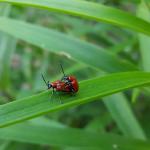 Lily Leaf Beetle: Lilioceris lilii adults overwinter in sheltered places. As soon as susceptible hosts such as Lilium spp. (Turk’s cap, tiger, Easter, Asiatic, and Oriental lilies) and Fritillaria spp. break through the ground, the adult lily leaf beetles are known to feed on the new foliage. (Note: daylilies are not hosts.) Typically, in May, mating will occur and each female will begin to lay 250-450 eggs in neat rows on the underside of the foliage. If there are only a few plants in the garden, hand picking and destroying overwintering adults can help reduce local garden-level populations at that time.
Lily Leaf Beetle: Lilioceris lilii adults overwinter in sheltered places. As soon as susceptible hosts such as Lilium spp. (Turk’s cap, tiger, Easter, Asiatic, and Oriental lilies) and Fritillaria spp. break through the ground, the adult lily leaf beetles are known to feed on the new foliage. (Note: daylilies are not hosts.) Typically, in May, mating will occur and each female will begin to lay 250-450 eggs in neat rows on the underside of the foliage. If there are only a few plants in the garden, hand picking and destroying overwintering adults can help reduce local garden-level populations at that time.
Check out Episode 3 of InsectXaminer to see the lily leaf beetle in action: https://ag.umass.edu/landscape/education-events/insectxaminer
-
Magnolia Scale: Neolecanium cornuparvum overwinters as first instar nymphs which are elliptical, and dark slate gray in color and can usually be found on the undersides of 1 and 2 year old twigs. Nymphs may molt by late April or May and again by early June at which time the scales may be purple in color. Eventually nymphs secrete a white powdery layer of wax over their bodies. Dormant oils can be applied between 7-35 GDD’s targeting the overwintering nymphs. Avoid applications to opening buds or blooms.
-
 Pine Bark Adelgid: Pineus strobi overwinters as an immature which begins feeding during the first days of warm weather in the spring and begins secreting white wax over itself, which can eventually coat the entire trunk of infested trees. Egg laying may begin in April. This insect can be found on the trunk, branches, twigs, and the base of needles on new shoots. Spruce is a secondary host but this adelgid can repeatedly reproduce itself on pine. Wash off bark with a strong jet of water. If necessary, dormant oil applications can be made in mid-late April between 22-58 GDDs. Hosts include eastern white, Scots, and Austrian pines. This insect does little damage to healthy trees and can often be tolerated.
Pine Bark Adelgid: Pineus strobi overwinters as an immature which begins feeding during the first days of warm weather in the spring and begins secreting white wax over itself, which can eventually coat the entire trunk of infested trees. Egg laying may begin in April. This insect can be found on the trunk, branches, twigs, and the base of needles on new shoots. Spruce is a secondary host but this adelgid can repeatedly reproduce itself on pine. Wash off bark with a strong jet of water. If necessary, dormant oil applications can be made in mid-late April between 22-58 GDDs. Hosts include eastern white, Scots, and Austrian pines. This insect does little damage to healthy trees and can often be tolerated. -
Snowball Aphid: Neoceruraphis viburnicola eggs overwinter on viburnum twigs and buds. Eggs hatch and this aphid becomes active on certain species of viburnum roughly between 148-298 GDD’s or around redbud bloom. This insect is particularly noticeable on V. opulus, V. prunifolium, and V. acerifolia. Stem mothers, appearing blueish-white, can be found in curled up and distorted foliage. Damage caused by this insect pest is mostly aesthetic.
-
Spruce Bud Scale: Physokermes piceae is a pest of Alberta and Norway spruce, among others. Immatures overwinter on the undersides of spruce needles, dormant until late March. By April, females may move to twigs to complete the rest of their development. Dormant oil applications may be made between 22-121 GDDs. Follow all label instructions, as oil may remove the bluish color from certain conifers. Mature scales are reddish brown, globular, 3 mm. in diameter, and found in clusters of 3-8 at the base of new twig growth. They closely resemble buds and are often overlooked. Crawlers are present around June.
-
Spruce Spider Mite: Oligonychus ununguis is a cool-season mite that becomes active in the spring from tiny eggs that have overwintered on host plants. Hosts include spruce, arborvitae, juniper, hemlock, pine, Douglas-fir, and occasionally other conifers. This particular species becomes active in the spring and can feed, develop, and reproduce through roughly June. When hot, dry summer conditions begin, this spider mite will enter a summer-time dormant period (aestivation) until cooler temperatures return in the fall. This particular mite may prefer older needles to newer ones for food. When damaging spruce spider mite populations are known from last season, dormant oil applications can be made (when temperatures are appropriate according to label instructions) between 7-121 GDD’s, base 50°F (April). Magnification is required to view spruce spider mite eggs. Tapping host plant branches over white paper may be a useful tool when scouting for spider mite presence. (View with a hand lens.) Spider mite damage may appear on host plant needles as yellow stippling and occasionally fine silk webbing is visible.
-
Viburnum Leaf Beetle: Pyrrhalta viburni is a beetle in the family Chrysomelidae that is native to Europe, but was found in Massachusetts in 2004. Viburnum leaf beetle overwinters as eggs laid in capped pits on the newest growth of susceptible viburnum branches. Scout for overwintered eggs and prune out and destroy before they hatch. Egg hatch occurs in late-April to early-May as temperatures warm and foliage becomes available. Monitor for larvae in mid-May (80-120 GDD’s). This beetle feeds exclusively on many different species of viburnum, which includes, but is not limited to, susceptible plants such as V. dentatum, V. nudum, V. opulus, V. propinquum, and V. rafinesquianum. Some viburnum have been observed to have varying levels of resistance to this insect, including but not limited to V. bodnantense, V. carlesii, V. davidii, V. plicatum, V. rhytidophyllum, V. setigerum, and V. sieboldii. More information about viburnum leaf beetle may be found at http://www.hort.cornell.edu/vlb/ .
-
White Pine Weevil: Pissodes strobi adults overwinter in sheltered locations in the leaf litter and become active very early in the spring, when daytime temperatures reach 50°F and before the bloom of forsythia (between 7-58 GDDs). Hosts include eastern white pine, Norway spruce, scotch, pitch, and red pine, blue spruce, and white spruce. Adults will begin feeding on bark 7-10 inches below dormant terminal buds. Females will deposit eggs in terminal growth bark, and developing larvae will feed in leaders until they mature in July when pupation occurs in pupal chambers made of wood chips. Management in nurseries or Christmas tree production may be necessary. Target adults between 7-58 GDD’s.
-
Woolly Apple Aphid: Eriosoma lanigerum may be found on apple, crabapple, hawthorn, mountain-ash, Pyracantha, and elm hosts. The primary (winter) host is elm, on which aphids infest emerging spring leaves, causing leaves to curl or close into stunted, rosette-like clusters found at twig tips. On apple and crabapple, this species of aphid colonizes roots, trunks, and branches in the summer and is commonly found near previous wounds or callous tissue. On roots, the aphids cause swelled areas which can girdle and kill roots. The aphids, when found in above ground plant parts such as elm leaves, are covered with white wax. Eggs are the overwintering stage on elm, which hatch in the spring in time for the nymphs to infest new elm foliage. Following a few generations on elm, the aphids will develop into a winged form, which will disperse and seek out apple and crabapple. Multiple generations will occur on these alternate hosts in the summer and by the fall, a winged form will return to elm and mated females will lay eggs near elm buds. These aphids are a favorite snack for insect predators such as the multicolored Asian lady beetle, Harmonia axyridis.
-
Woolly Elm Aphid: Eriosoma americanum females lay a single egg in the cracks and crevices of elm bark, where the egg overwinters. Eggs hatch on elm in the spring as leaves are unfolding. Aphids may be active from 121-246 GDD’s, base 50°F on elm. A young, wingless female hatched from the egg feeds on the underside of leaf tissue. This female aphid matures and gives birth to 200 young, all females, without mating. These aphids feed, and the elm leaf curls around them and protects them. By the end of June, winged migrants mature and find serviceberry hosts. Another set of females is produced. These new females crawl to and begin feeding on the roots of serviceberry. Multiple generations occur on the roots of serviceberry through the summer.
Concerned that you may have found an invasive insect or suspicious damage caused by one? Need to report a pest sighting? If so, please visit the Massachusetts Introduced Pests Outreach Project: http://massnrc.org/pests/pestreports.htm .
Reported by Tawny Simisky, Extension Entomologist, UMass Extension Landscape, Nursery, & Urban Forestry Program
Landscape Practices
 Hamamelis x intermedia is a sight for sore eyes as one of the plants to bloom in the spring. A hybrid between Hamamelis japonica and H. mollis, H. intermedia is a medium to large shrub growing 12-20’ tall. They are noted for their crinkly, spider-like flowers in later winter prior to leaf emergence in spring. Flower color varies by cultivar ranging from yellow to orange to red. Popular cultivars include: ‘Arnold’s Promise’ (bright yellow), ‘Diane’ (red), ‘Jenela’ (coppery orange), and ‘Pallida’ (sulfur yellow). Also attractive in autumn, fall color can range from yellow to red.
Hamamelis x intermedia is a sight for sore eyes as one of the plants to bloom in the spring. A hybrid between Hamamelis japonica and H. mollis, H. intermedia is a medium to large shrub growing 12-20’ tall. They are noted for their crinkly, spider-like flowers in later winter prior to leaf emergence in spring. Flower color varies by cultivar ranging from yellow to orange to red. Popular cultivars include: ‘Arnold’s Promise’ (bright yellow), ‘Diane’ (red), ‘Jenela’ (coppery orange), and ‘Pallida’ (sulfur yellow). Also attractive in autumn, fall color can range from yellow to red.
Report by Mandy Bayer, Extension Assistant Professor of Sustainable Landscape Horticulture, UMass Stockbridge School of Agriculture
Additional Resources
Pesticide License Exams - The MA Dept. of Agricultural Resources (MDAR) is now holding exams online. For more information and how to register, go to: https://www.mass.gov/pesticide-examination-and-licensing.
To receive immediate notification when the next Landscape Message update is posted, join our e-mail list or follow us on Facebook.
For a complete listing of upcoming events, see our upcoming educational events https://ag.umass.edu/landscape/upcoming-events
For commercial growers of greenhouse crops and flowers - Check out UMass Extension's Greenhouse Update website
For professional turf managers - Check out Turf Management Updates
For home gardeners and garden retailers - Check out our home lawn and garden resources.
Diagnostic Services
UMass Laboratory Diagnoses Landscape and Turf Problems - The UMass Extension Plant Diagnostic Lab is available to serve commercial landscape contractors, turf managers, arborists, nurseries and other green industry professionals. It provides woody plant and turf disease analysis, woody plant and turf insect identification, turfgrass identification, weed identification, and offers a report of pest management strategies that are research based, economically sound and environmentally appropriate for the situation. Accurate diagnosis for a turf or landscape problem can often eliminate or reduce the need for pesticide use. For sampling procedures, detailed submission instructions and a list of fees, see Plant Diagnostic Laboratory
Soil and Plant Nutrient Testing - The University of Massachusetts Soil and Plant Nutrient Testing Laboratory is located on the campus of The University of Massachusetts at Amherst. Testing services are available to all. The lab provides test results and recommendations that lead to the wise and economical use of soils and soil amendments. For more information, including current turn-around times, visit the UMass Soil and Plant Nutrient Testing Laboratory web site. The lab is currently accepting new orders for Routine Soil Analysis (including optional Organic Matter, Soluble Salts, and Nitrate testing), Particle Size Analysis, Pre-Sidedress Nitrate (PSNT), and Soilless Media (no other types of soil analyses available at this time). Turnaround time: Please plan for the fact that date of receipt in the lab is affected by weekends, holidays, shipping time, and time for UMass Campus Mail to deliver samples to the lab.
Tick Testing - The UMass Center for Agriculture, Food, and the Environment provides a list of potential tick identification and testing options at: https://ag.umass.edu/resources/tick-testing-resources.
Acknowledgements: UMass Extension gratefully acknowledges the support of the following funding sources for the production of the Landscape Message –
- The Massachusetts Nursery and Landscape Association Fund
- The Massachusetts Department of Conservation and Recreation, Award #ISADCR28219926UMA22A
- Stakeholders like you! The Landscape Message is partially supported by educational program user fees.
